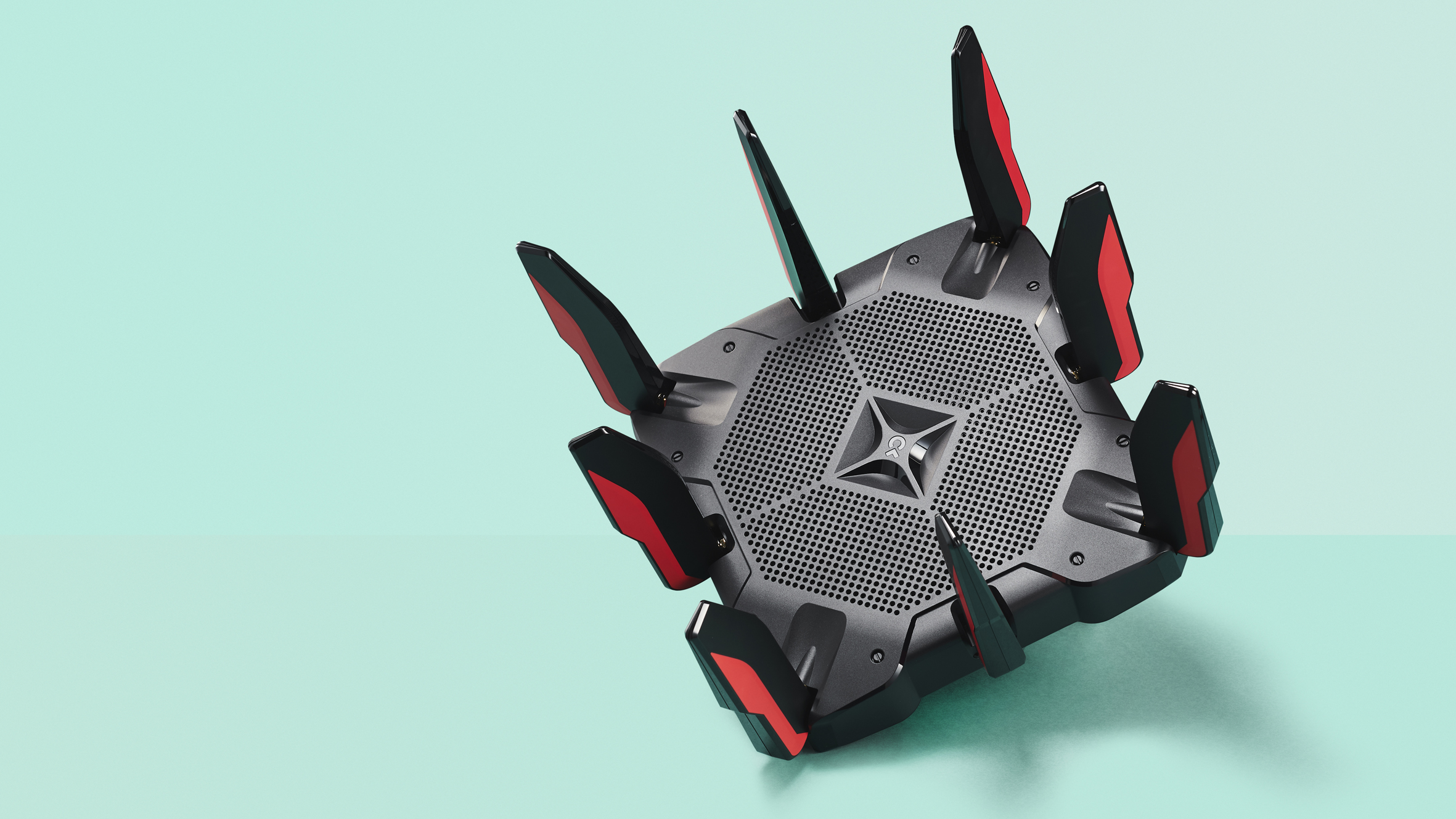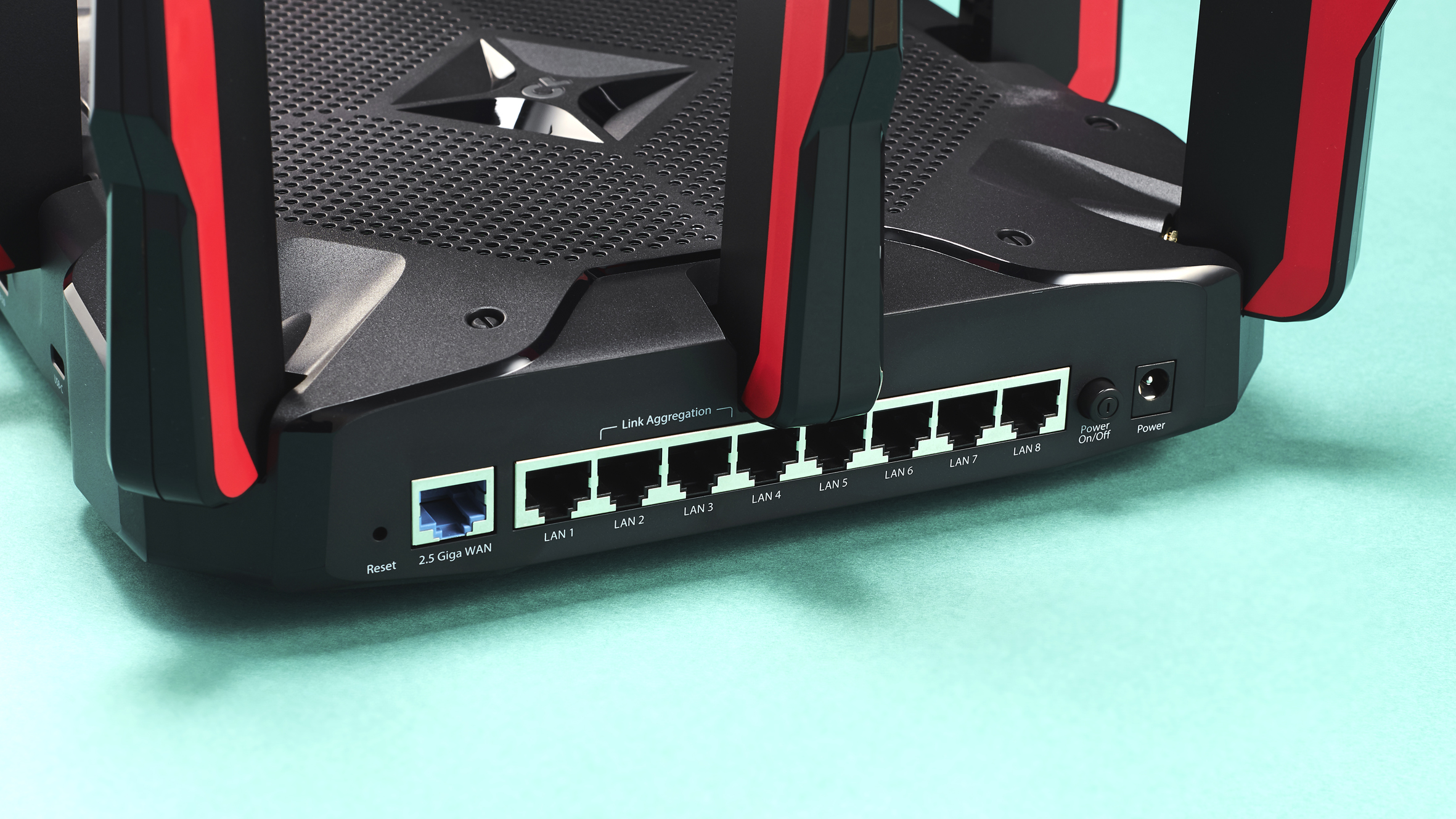TP-Link Archer AX11000 review: big things come in big packages
The TP-Link Archer AX11000 is a top-notch gaming router, but we wish it would ditch the ‘gamer’ aesthetics


While the TP-Link Archer AX11000 does deliver best-in-class Wi-Fi speed and range, it’s imposingly large and the design won’t be to everyone’s tastes. The high price point is unfortunate, too. If the sight of it didn’t make you go wide-eyed with rightful aesthetic horror, though, TP-Link are offering a powerful solution for online gaming that comes equipped with a useful suite of proprietary firmware and physical connectivity that is virtually unparalleled.
-
+
Fantastic performance
-
+
Long Wi-Fi range
-
+
8 Ethernet ports
-
+
Excellent software control
-
-
Setup takes a while
-
-
Extremely bulky
-
-
Expensive
Why you can trust T3
TP-Link Archer AX11000 review

Dimensions: 11.3 x 11.3 x 7.2 inches
Weight: 2.9 lbs
Class: AX11000
CPU: Quad-core 1.8GHz
RAM: 1GB
Flash memory: 512MB
Speed: 10 Gbps: 4804 Mbps + 4804 Mbps + 1148 Mbps
Frequency: Tri-band (2.4GH + 5GHz + 5GHz Gaming)
Standard: ax/ac/n/a 5 GHz, ax/n/b/g 2.4 GHz
Antennas: 8
Connections: 1 x USB 3.0, 1 x USB-C 3.0, 1 x 2.5GHz Ethernet, 8 x Gigabit LAN
Features: Enable/Disable Wireless Radio, Guest network, DFS, MU-MIMO, OFDMA, Archer Game Suite, Parental Controls
View now at Amazon
Almost four hundred pounds for a router does feel faintly ridiculous. No, TP-Link’s new Archer AX11000 isn’t any more expensive than other routers in the same class - in fact, it exactly shares a price point with Asus’s AX11000 model - but unless you live in a palace, it still seems like a high asking price. Actually, even if you do happen to live in a palace, Wi-Fi range extenders aren’t that expensive.
You do get a lot for your money, not least in the physical sense. The Archer AX11000 is one of the biggest gaming routers we’ve ever seen, weighing almost three kilos and measuring 9.5 inches on each of its long edges. It’s a big black square, with eight red-accented antenna stretching upwards and LED lighting. It’s very much a piece of ‘gamer’ hardware; in fact, it looks rather like a spider had unsavoury intimate relations with a gaming PC. It’s certainly not what we’d like to see in terms of aesthetic router design. We find ourselves longing for the beautiful simplicity of Netgear’s Orbi series.
TP-Link Archer AX11000 review: Hardware Performance
Fortunately, your cash also gets you some incredibly good internal hardware. A quad-core processor equipped with a gigabyte of RAM means that this router is more powerful than many computers were a decade ago. There’s practically no danger of router-caused lag here; the CPU chews through any amount of throughput effortlessly, guaranteeing fast speeds.
Wi-Fi 6 is built-in, so recent laptops and gaming PCs are able to take advantage of higher speed connections from the get go. The AX11000 is monstrously fast, capable of wireless data transfers of up to 10756 Mbps. Of course, you’ll need to be paying for high-speed fiber-optic internet to properly benefit, and your devices will need to be AX Wi-Fi compatible; recently released computers and phones are more likely to support it.
This Archer router absolutely dominates in terms of Wi-Fi reach and reception
The Tri-band setup means that more devices can be connected simultaneously than the majority of other routers, ideal if you’ve got a household full of gamers and content streamers. One 5G band is specifically dedicated to gaming, meaning that different users on the AX11000’s network don’t have to fight for bandwidth, and DFS technology can automatically push users to vacant lanes to keep speeds high.
It’s not just about speed, though, and we’re pleased to report that this Archer router absolutely dominates in terms of Wi-Fi reach and reception. Strong signal is still present 10m away from the router, through two walls, absolutely destroying the range of stock routers from ISPs.
Internet speeds also weren’t as strongly affected by walls compared to older routers. Even through two walls, we were still able to get just under 800Mbps download speed. For large houses, the AX11000 certainly has the range.
Get all the latest news, reviews, deals and buying guides on gorgeous tech, home and active products from the T3 experts

TP-Link Archer AX11000 review: Assembly and Setup
Unboxing the Archer AX11000 took us a while, as every antenna is individually wrapped and must be fitted manually onto the router’s main unit. Setting up the router took even longer, and we weren’t too impressed by the boot-up time - the AX11000 took over a minute to power up and start connecting to devices.
Thanks to four brackets for flathead screws, the AX11000 can be easily mounted on a wall or ceiling, although the size and appearance means that we wouldn’t particularly want it hanging from our ceiling. It’s not disastrous, but we’ve seen better.
The stock Ethernet and power cables that come with the AX11000 aren’t very long either, which could be frustrating depending on the layout of Ethernet ports in your home. The included Ethernet cable isn’t 2.5G either, despite the router having a 2.5G port.
TP-Link Archer AX11000 review: Features and Software
In terms of physical features, the Archer AX11000 has it all. Eight ports for wired connections mean you can support a whole LAN party’s worth of gaming PCs, plus USB-A and USB-C - one each.
There are three buttons on the router (not including the power and reset buttons). These are for LED control, WPS configuration, and Wi-Fi power. Switching off Wi-Fi with this button doesn’t deactivate wired connections, so you can safely cut the kids’ wireless internet off without cutting the connection to your desktop PC.
A whole suite of TP-Link firmware accompanies the AX11000 when you first set it up. Most useful is the ‘Game Accelerator’ function, which automatically detects games being played on the home network and optimises their streams, reducing ping and ensuring that the game is connected via the least busy Wi-Fi band.
‘Game Diagnostics’ isn’t quite as useful, allowing you to check up on stats like real-time latency and hours spent in-game, but the overall UI discouraged us from spending too much time in it. An overabundance of dark red means that a lot of text is difficult to read.
Lastly, ‘Game Protector’ is essentially just a TP-Link themed iteration of Trend Micro’s HomeCare antivirus software, keeping your cybersecurity up-to-date directly from the router. There’s also full support in the AX11000’s firmware for port forwarding and VPN configuration.

TP-Link Archer AX11000 review: Verdict
This review might have felt critical in places, but it’s vitally important to remember that this isn’t a product for most people. AX11000-class routers are new, with only a few models available from a handful of manufacturers and only new devices capable of taking proper advantage of it; this is the absolute top-of-the-line right now, and it has a price point to match.
The Archer AX11000 is essentially unbeaten in terms of performance. We’ve yet to see a router that can deliver better wireless internet speeds through walls, floors and ceilings. The software UI is a little ugly, but it functions well and the router’s smart technology means that multiple Wi-Fi connections don’t slow the Archer down. It’s a brilliant gaming router - we just wish it didn’t look like that.